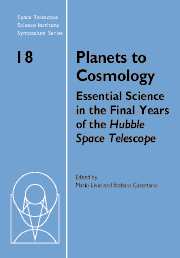 Planets to Cosmology
Planets to Cosmology Book contents
- Frontmatter
- Contents
- Participants
- Preface
- Hubble's view of transiting planets
- Unsolved problems in star formation
- Star formation in clusters
- HST abundance studies of low metallicity stars
- Physical conditions and feedback: HST studies of intense star-forming environments
- Quasar hosts: Growing up with monstrous middles
- Reverberation mapping of active galactic nuclei
- Feedback at high redshift
- The baryon content of the local intergalactic medium
- Hot baryons in supercluster filaments
- Galaxy assembly
- Probing the reionization history of the Universe
- Studying distant infrared-luminous galaxies with Spitzer and Hubble
- Galaxies at z ≈ 6–i′-drop selection and the GLARE Project
- The Hubble Ultra Deep Field with NICMOS
Reverberation mapping of active galactic nuclei
Published online by Cambridge University Press: 17 August 2009
- Frontmatter
- Contents
- Participants
- Preface
- Hubble's view of transiting planets
- Unsolved problems in star formation
- Star formation in clusters
- HST abundance studies of low metallicity stars
- Physical conditions and feedback: HST studies of intense star-forming environments
- Quasar hosts: Growing up with monstrous middles
- Reverberation mapping of active galactic nuclei
- Feedback at high redshift
- The baryon content of the local intergalactic medium
- Hot baryons in supercluster filaments
- Galaxy assembly
- Probing the reionization history of the Universe
- Studying distant infrared-luminous galaxies with Spitzer and Hubble
- Galaxies at z ≈ 6–i′-drop selection and the GLARE Project
- The Hubble Ultra Deep Field with NICMOS
Summary
Reverberation mapping is a proven technique that is used to measure the size of the broad emission-line region and central black hole mass in active galactic nuclei. More ambitious reverberation mapping programs that are well within the capabilities of the Hubble Space Telescope could allow us to determine the nature and flow of line-emitting gas in active nuclei and to assess accurately the systematic uncertainties in reverberation-based black hole mass measurements.
Introduction: The inner structure of AGNs
There is now general consensus that the long-standing paradigm for active galactic nuclei (AGNs) is basically correct, i.e., that AGNs are fundamentally powered by gravitational accretion onto supermassive collapsed objects. Details of the inner structure of AGNs, however, remain sketchy, although both emission lines and absorption lines reveal the presence of large-scale gas flows on scales of hundreds to thousands of gravitational radii. The accretion disk produces a time-variable high-energy continuum that ionizes and heats this nuclear gas, and the broad emission-line fluxes respond to the changes in the illuminating flux from the continuum source. The geometry and kinematics of the broad-line region (BLR), and fundamentally, its role in the accretion process, are not understood. Immediate prospects for understanding this key element of AGN structure do not seem especially promising with the realization that the angular size of the nuclear regions projects to only microarcsecond scales even in the case of the nearest AGNs.
Information
- Type
- Chapter
- Information
- Planets to CosmologyEssential Science in the Final Years of the Hubble Space Telescope: Proceedings of the Space Telescope Science Institute Symposium, Held in Baltimore, Maryland May 3–6, 2004, pp. 89 - 98Publisher: Cambridge University PressPrint publication year: 2006
Accessibility standard: Unknown
Why this information is here
This section outlines the accessibility features of this content - including support for screen readers, full keyboard navigation and high-contrast display options. This may not be relevant for you.Accessibility Information
- 7
- Cited by